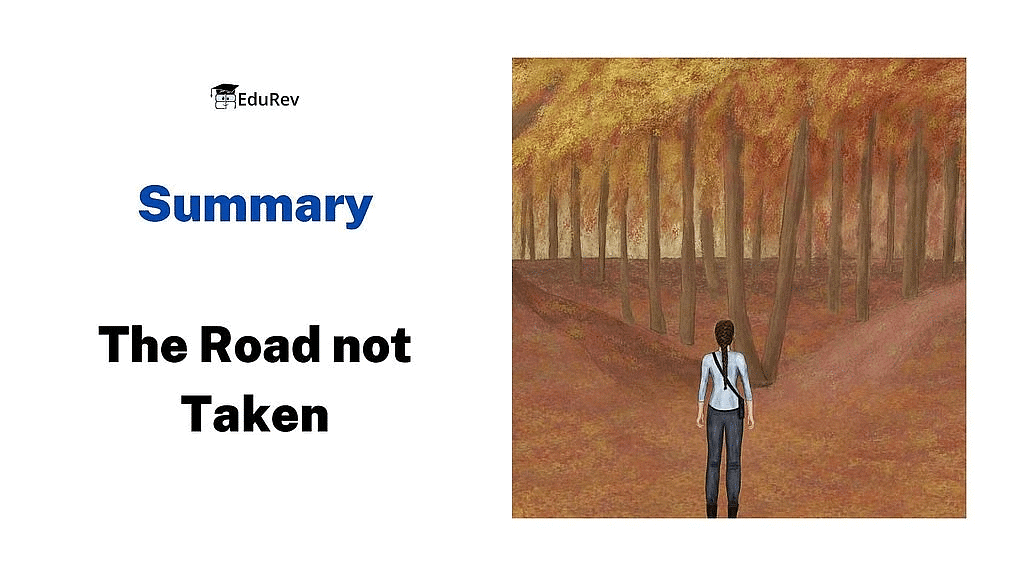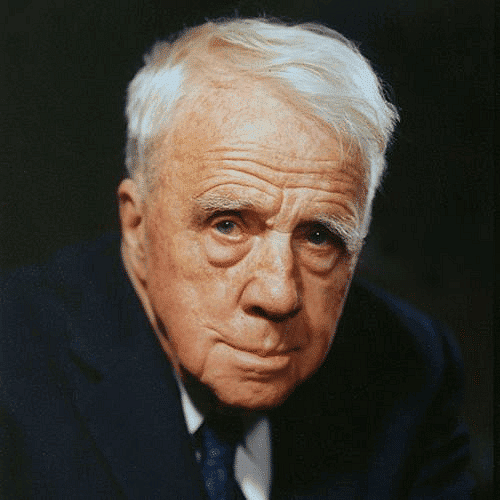The Road Not Taken Summary Class 9 English Beehive Chapter 1
| Table of contents |

|
| About the Poet |

|
| Key Points of the Poem |

|
| Detailed Summary |

|
| Title Justification |

|
| Theme/Message |

|
| Literary Devices |

|
| Difficult Words |

|
Class 9 English Poem "The Road Not Taken" by Robert Frost signifies a situation where the poet was walking down a road that had a diversion. He had to choose between the two paths. Below is a concise summary of the poem.

About the Poet
Robert Frost, born in 1874 in San Francisco, faced early tragedy with the loss of his father. He attended Dartmouth and Harvard but left without a degree. Frost married Elinor White and had six children. He began his poetic journey in England in 1912, gaining recognition for his reflections on rural life. Despite personal hardships, including the loss of children, Frost persevered and became a celebrated American poet with works like "The Road Not Taken" and "Stopping by Woods on a Snowy Evening." His legacy, marked by simplicity and profound themes of nature and choice, continues to inspire readers worldwide.
 Robert Frost
Robert Frost
Key Points of the Poem
- In "The Road Not Taken," the poet reflects on life's choices through a metaphorical journey in the woods. When faced with a fork in the road, he experiences a dilemma about which path to take.
- Despite his desire to travel both roads, he knows he must choose just one. He carefully considers his options, ultimately selecting the less traveled path. This decision, he believes, will have a significant impact on his life's course. The poet describes the characteristics of each road, noting the grassy and less worn appearance of the chosen path.
- He acknowledges that both roads are likely to have been traveled similarly by others. Despite his uncertainty about the outcome, he takes the less frequented route, believing it will make a difference in his life's journey.
- Reflecting on his decision, he imagines telling others in the future about the choice he made and how it influenced his life's path. Through this narrative, the poet explores the theme of individual choices and their impact on destiny.
Detailed Summary
Two roads diverged in a yellow wood,
And sorry I could not travel both
And be one traveler, long I stood
And looked down one as far as I could
To where it bent in the undergrowth;
The speaker, walking through a forest whose leaves have turned yellow in autumn, comes to a fork in the road. The speaker, regretting that he is unable to travel by both roads (since he is, after all, just one person), stands at the fork in the road for a long time and tries to see where one of the paths leads. However, the speaker can't see very far because the forest is dense and the road is not straight.
Then took the other, as just as fair,
And having perhaps the better claim,
Because it was grassy and wanted wear;
Though as for that the passing there
Had worn them really about the same,
The speaker takes the other path, judging it to be just as good a choice as the first, and supposing that it may even be the better option of the two, since it is grassy and looks less worn than the other path. Though, now that the speaker has actually walked on the second road, he thinks that in reality the two roads must have been more or less equally worn-in.
And both that morning equally lay
In leaves no step had trodden black.
Oh, I kept the first for another day!
Yet knowing how way leads on to way,
I doubted if I should ever come back.
Reinforcing this statement, the speaker recalls that both roads were covered in leaves, which had not yet been turned black by foot traffic. The speaker exclaims that he is in fact just saving the first road, and will travel it at a later date, but then immediately contradicts him or herself with the acknowledgement that, in life, one road tends to lead onward to another, so it's therefore unlikely that he will ever actually get a chance to return to that first road.
I shall be telling this with a sigh
Somewhere ages and ages hence:
Two roads diverged in a wood, and I—
I took the one less traveled by,
And that has made all the difference.
The speaker imagines him or herself in the distant future, recounting, with a sigh, the story of making the choice of which road to take. Speaking as though looking back on his or her life from the future, the speaker states that he was faced with a choice between two roads and chose to take the road that was less traveled, and the consequences of that decision have made all the difference in his or her life.
Title Justification
The title "The Road Not Taken" is apt for Robert Frost's poem for several reasons.
- Firstly, the title captures the central metaphor of the poem, which is the diverging paths that the poet encounters. The phrase "The Road Not Taken" refers to the choice the poet must make between two different paths, highlighting the theme of decision-making and the significance of the chosen path in shaping one's life.
- Additionally, the title conveys a sense of reflection and contemplation, which aligns with the introspective tone of the poem. The speaker looks back on the pivotal moment of decision-making and ponders the significance of the chosen path. The phrase "The Road Not Taken" evokes a sense of curiosity about the unexplored path and the potential outcomes that could have resulted from choosing differently.
In summary, the title "The Road Not Taken" aptly captures the key themes of decision-making, the long-term impact of choices, and the reflective nature of the poem.
Theme/Message
Theme
- The theme of Robert Frost's poem "The Road Not Taken" revolves around the significance of choices in life and the consequences they bear.
- It explores the dilemma of decision-making and the impact of those choices on our future.
Message
- The poem's message emphasizes the importance of thoughtful decision-making and the recognition that our choices have far-reaching implications.
- It cautions readers to consider the potential outcomes and consequences before making decisions. Additionally, it highlights the idea that once a choice is made, it is difficult to backtrack and start anew.
- The poem encourages individuals to be mindful of the paths they choose, as these decisions ultimately shape their future. Ultimately, the poem serves as a reminder to be conscious and responsible decision-makers, as our choices define our destiny.
Literary Devices
- Assonance and Consonance - Repetition of vowel sounds (assonance) and consonant sounds (consonance) in nearby words.
Example: In "The Road Not Taken," Frost uses both to create a balanced and rhythmic effect. Vowel sounds like "O" are repeated throughout, while consonants like "L" and "W" are strategically placed. - Extended Metaphor - An extended metaphor develops over several lines, serving as a central theme. In "The Road Not Taken," Frost's metaphor of a forked path symbolizes decision-making.
Allows readers to relate to the speaker's dilemma and reflect on their own choices. - Repetition - Frost employs diacope (repetition of a word with others in between), anaphora (repetition of a word or phrase at the beginning of successive clauses), and thematic repetition.
Examples: Phrases like "way leads on to way" and the repeated opening line emphasize the poem's rhythm and themes. - Alliteration: Wanted Wear ‘w’ sound is repeating
‘first for’ – ‘f’ sound is repeating
‘though, that’- ‘th’ sound is repeating - Anaphora - ‘and’ repeated at the beginning of lines 2, 3 and 4
- Rhyme Scheme - abaab
- Symbolism - two roads that represent two or more choices in our life
Difficult Words
- Diverged = branched off, took different directions
- Wood = forest, dense group of trees
- Travel = to journey, move from one place to another
- Traveller = one who journeys, an explorer
- Undergrowth = Where clarity ends and uncertainty begins, the hidden segment of a choice or path
- Fair = unbiased, equitable, just
- Claim = assertion, a declaration of truth or belief
- Grassy = covered with grass, verdant
- Wanted wear = had not been crushed or worn out under human feet, has not been used and worn so frequently
- Trod = walked upon, stepped on
- Equally= Similarly, in the same manner, or measure
- Lay = was situated or placed
- Sigh = deep breath of sorrow, regret
- Kept = reserved, saved for later
- Telling = narrating, recounting
- Difference = distinction, variation in outcome or results
- Bent = curved, turned
- Doubted = questioned, was uncertain about Question for Summary: The Road Not TakenTry yourself:Which literary device is used when a vowel sound is repeated in nearby words in a poem?View Solution
|
119 videos|620 docs|82 tests
|
FAQs on The Road Not Taken Summary Class 9 English Beehive Chapter 1
| 1. Who is the poet of "The Road Not Taken"? |  |
| 2. What is the central theme of "The Road Not Taken"? |  |
| 3. What literary devices are used in "The Road Not Taken"? |  |
| 4. How does the poem conclude regarding the speaker's choice? |  |
| 5. Why is the title "The Road Not Taken" significant? |  |

|
Explore Courses for Class 9 exam
|

|


















